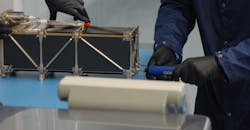Miniature Satellite Speeds Communications from Space
Satellite systems depend on fast, cost-effective launches of spacecraft. In order to meet pressing needs for lower-cost, smaller satellite systems, Aerospace Corp. has developed its Rapid + Responsive + Reimagined (R3) CubeSat system as an experiment in low-earth-orbit (LEO) satellite technology that can provide reliable satellite services at a fraction of the cost of traditional space-based systems. The R3 CubeSat system was launched on Dec. 15, 2018 from Rocket Lab’s small Electron satellite launcher from its New Zealand launch site.
“Our Innovation Lab (iLab) supported the development of this new technology in half the time it takes to build larger systems,” said Dr. Randy Villahermosa, executive director of iLab. “R3 is two percent of the size of larger spacecraft and three percent of the cost of larger satellites. Our plan is to experiment with several off-board artificial intelligence (AI) technologies that will be critical to creating future space capabilities and building resilient architectures. For example, automated image processing and feature-flagging using AI.”
The R3 satellite is demonstrating the capabilities of a smaller satellite by using a multispectral imager to capture images from space and then transmitting those images to earth by means of 200-Mb/s laser communications downlink. This high-speed link is currently providing space-to-ground communications that is 100 times the rate than any other current CubeSat in orbit. “R3 is just one example of our innovation strategy to develop new capabilities in the lab that can be tested quickly on CubeSats to buy down risk in future operational systems,” said Villahermosa.
About the Author
Jack Browne
Technical Contributor
Jack Browne, Technical Contributor, has worked in technical publishing for over 30 years. He managed the content and production of three technical journals while at the American Institute of Physics, including Medical Physics and the Journal of Vacuum Science & Technology. He has been a Publisher and Editor for Penton Media, started the firm’s Wireless Symposium & Exhibition trade show in 1993, and currently serves as Technical Contributor for that company's Microwaves & RF magazine. Browne, who holds a BS in Mathematics from City College of New York and BA degrees in English and Philosophy from Fordham University, is a member of the IEEE.

